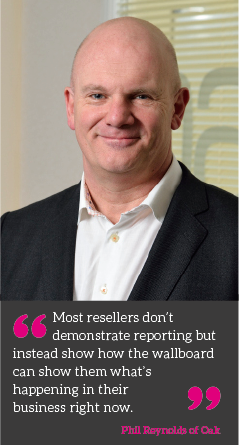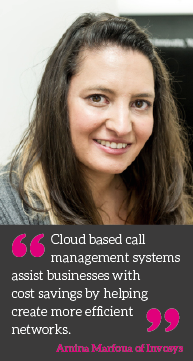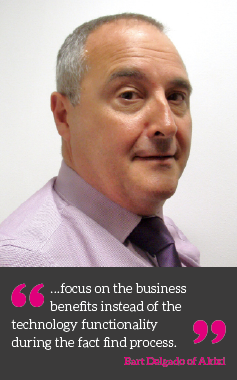
Communications management products are a great way to find out more about your customer as well as being a vehicle through which your clients can measure and control their costs as Comms Business Magazine reports.
Bill Gates once said that how you gather, manage and use information would determine whether you win or lose.
We’re not sure how long ago he said that but we reckon that today it rings ever more true and the call management applications we now have are far more than the call loggers of yesteryear with integration to applications such as call recording and extensive management reporting.
According to Phil Reynolds, Joint CEO at Oak, the main change in recent years is the introduction of the wallboard showing not just call management statistics but other business metrics pulled from the customer’s internal systems.
 “The wallboard is normally displayed on a big screen in reception or in other prominent positions within the office premises. Most resellers don’t demonstrate reporting but instead show how the wallboard can show them what’s happening in their business right now. No longer are the business analytics hidden in the depths of various reports but presented in dramatic form where they can make a real difference right now to how calls are being answered or how many calls are being made.
“The wallboard is normally displayed on a big screen in reception or in other prominent positions within the office premises. Most resellers don’t demonstrate reporting but instead show how the wallboard can show them what’s happening in their business right now. No longer are the business analytics hidden in the depths of various reports but presented in dramatic form where they can make a real difference right now to how calls are being answered or how many calls are being made.
Call management is nearly always sold with other applications with call recording being the big one. If you combine call reporting, live wallboard displays and call recording you have a very powerful proposition where the whole is greater than the sum of its parts. It’s also a solution sale as opposed to a simple add on which of course is much more valuable to a customer. We also see call reporting providing the statistical backup to contact centre reporting solutions as only a proportion of extensions are used in the call centre element, the rest being the normal office phones.
We also see call reporting sold alongside CRM integration where incoming and outgoing calls pop up the customer records on screen as the calls are received or made. Again the wallboard element which focuses on customer service is a key element of the solution as the aim is to handle calls more quickly right now and to get immediate feedback.
From a call logging point of view it depends whether it’s being used at the front end or the back end of an organisation - to show something has been done in the past or whether it’s a proactive tool; live stats for example. Live stats are very important. In the past you could only look at yesterday’s stats but everyone now wants to look at the last hour’s information. Live capability is vital in dealing with any issues such as missed calls, there and then.
Call Management has become more instant than historical. It was more of a data tool to look back at, such as the number of calls per month or year, but that’s not the case today. It’s a lot more immediate, intuitive and flexible. Because organisations view themselves a lot more as an informal call centre this has had an impact on the market and the technology being developed. Who’s logged in, who’s not, are all part of the same call centre tool along with live and historical data. The market is being driven by informal call centres and their continued expansion.
In addition people can access these technologies a lot more now. Most phone systems have elements of call loggers built into them. This means people will use the basic features and then realise they may need something more.
Another trend to be aware of is that out-of-the-box capabilities have expanded. There used to be limited things they would link to - unless it was bespoke but then it became expensive. Now the list of packages a call logger will integrate with has expanded. It used to be Outlook but now there’s Salesforce and various CRM solutions that are more prevalent. Out-of-the-box can now integrate with say 20 different things rather than just two. This has driven integration and as more awareness is created this builds further momentum.”
Beyond Voice
David Rowlands, UK and EMEA Head of Virtual Contact Centres at 8x8 Solutions says that in the future, businesses will want to move beyond just voice to take into account different ways agents interact with customers.
“We expect features such as screen recording to become more commonplace. We may even see instant playbacks of completed calls provided to both the customer and the call handler as soon as you put the phone down, giving greater transparency for customers.
 There seems to be a trend of integrating call management products with other applications – call recording and call/contact centre for example. Is this the case and typically what additional opportunities do vendors provide the channel?
There seems to be a trend of integrating call management products with other applications – call recording and call/contact centre for example. Is this the case and typically what additional opportunities do vendors provide the channel?
We believe that the seamless integration of analytics software with contact centre solutions is key for tangible business growth. Our analytics software is often the solution that attracts the most attention from our partners and their customers. We know from this demand, integrated analytic solutions will be a burgeoning market.”
Bart Delgado of Akixi comments, “Cradle to Grave detailed reporting allows todays 5th generation tools to provide intimate detail of call transfers throughout an organisation to better handle those tricky customer complaints of poor service.
Real Time Wallboards with Key Performance metric displays ensure the entire team’s objectives are aligned to the task in hand and can often act as the supervisor on the wall.”
Amina Marfoua, Head of Product Development at Invosys also notes the change in working practices and that we’re now seeing a wealth of call management benefits to meet customer’s new requirements.
“The core features allow us to choose how, when and where calls are delivered, helping ensure we never miss a call. More and more PBX functionality is available through cloud based call management systems, giving companies more control to make simple changes themselves without having to wait for an engineer, thus increasing productivity.
As more businesses are embracing flexible working and using zero hours contracts, call management solutions enable this new employment style without losing any efficiency or visability. Live and historic reporting allows employers to manage staff effectively and have full confidence in how they are using their time, even when they are working remotely.
Companies today need to account for every penny they spend and several call management systems assist with this via monitoring. The use of multiple numbers and effective reporting means businesses can track every marketing campaign to ensure their money is being spent in the best way.
Cloud based call management systems assist businesses with cost savings by helping create more efficient networks. The ability to queue in the cloud means businesses are no longer limited by the number of channels they have available on site. Instead, they can queue in the cloud and only pay for the channels they use - considering most call centres work on a 3-1 ratio of lines to agents, they could see a potential saving of up to 1/3 on line rental charges.”
How can call management be used throughout an organisation? Say by the services team, help desk, accounts, sales & marketing etc. etc.
Amina Marfoua, Head of Product Development at Invosys says that today it’s not so much about the products – it’s about finding solutions.
“Call management products can be layered and used to complement a plethora of other software, hardware and applications.
It’s all about using the ‘best of breed’ products in the market to deliver a solution to many issues, beyond simply who answered the call and how long did the call last. Companies also want to know if the call was answered correctly, what was said, could the call be used for training purposes and did the marketing work.
Invosys have embraced this requirement in our agent ready product. A simple app for logging in and out of hunt groups which works seamlessly with our Number Manager product to ensure every call is answered as quickly and efficiently as possible, without losing calls to unavailable agents and unanswered mobiles.
Other great examples of integrating one or more products is adding voice recognition to call management systems as HMRC did or linking into payment systems to automate account payments as we see with many of the high street banks today.”
Phil Reynolds at Oak sees businesses using different wallboards in each area of their offices with the statistics that are most relevant to that department on display.
“The focus is of course to answer more calls more quickly on help desk and in service departments or make more calls in sales department. The use of CRM integration is on the up now that it is affordable to every business and now that nearly every business has a proper database for keeping their customer records.”
Paul Burn at Nimans says call management is undoubtedly being used in more areas especially if it’s built-in as standard.
 “End users with a site licence rather than individual ones are more prevalent in their usage. Otherwise it tends just to be a traditional focused tool. Cost and the benefits of the functionality restricted use before. If you have a service or help desk then you need live stats because customers want to know what’s happening now, not that they lost a call two days ago. It can definitely be rolled out across a business now.”
“End users with a site licence rather than individual ones are more prevalent in their usage. Otherwise it tends just to be a traditional focused tool. Cost and the benefits of the functionality restricted use before. If you have a service or help desk then you need live stats because customers want to know what’s happening now, not that they lost a call two days ago. It can definitely be rolled out across a business now.”
How best can resellers demonstrate the value of call management applications to their customers?
The historic precedent of reduced telephone bills is still valid but less important these days according to Phil Reynolds at Oak.
“The main focus of every forward thinking business is the constant drive to improve customer service and to improve staff productivity and call management with its associated add ons delivers this in spades. Naturally a solution sale is much more valuable to the end user. If you lead with “we have something that can revolutionise your business and pay for itself within 12 months” then it’s a no brainer. To be fair the ROI for some customers is achieved in just three or four months through increased productivity, less lost business, and a better perception of a business by its customers.
At Oak we have all the award winning call management options under one roof. To help our resellers we run regular sales and product training, provide dealer branded literature and do customer focussed webinars to close the sale for the dealer.
The future for call management is very bright but the days of the call logger sitting in a cupboard have long since passed, the information is far too valuable to be hidden away.”
Paul Burn at Nimans says this comes down to understanding what their customers are trying to achieve with their phone system - at the beginning of the sales cycle.
“Are they replacing technology to gain efficiency; is it old or is it based on cost? A lot of it boils down to the reasons why and the driving factors involved. The consultancy service at the front end is crucial, identifying how call management can make a business perform smarter and more efficiently. As the technology is now more affordable, then the ROI is not as big, making for a more compelling sale.”
David Rowlands at 8x8 Solutions believes that all aspects of businesses can benefit from advanced call management solutions.
“Giving our partners’ customers the ability to make informed decisions about their staff is critical to all growing businesses. Call management can be utilised to help improve employee performance, sales campaigns, customer experience management and offer greater insight into staffing and communications infrastructure requirements.”
Bart Delgado at Akixi says resellers need to focus on the business benefits instead of the technology functionality during the fact find process.
“Ask customers how many calls they are losing, how quickly they are answering calls, what the value of an order might be, how much they spend on marketing, how busy they are at different times and days and then show them how the technology is being used by the reseller to better manage such business conundrums, maybe even do so while visiting the customer on your tablet or smartphone to add impact.”
Reseller Comment:
David Groves, Director of Product Management, Azzurri Communications, says that call management applications enable enterprises to track costs and spending – hugely important from a practical perspective, but not exactly earth shattering. But where they can really stand out is in what they enable the IT department to do.
“The true advantage of call management applications and call-logging ability is where it enables an enterprise’s IT department to charge internally for the services it provides to the rest of the business. Moving from call management to a true understanding of other costs incurred in the provision of IT services is a way for the IT department to say ‘Yes, it is possible’ to a new proposal, by ensuring that the department proposing the idea pays for it. In this sense the call logger moves from a day-to-day cost monitor to a mechanism that affords an organisation added value. Cost management is not just controlling costs, but becomes a way for a business to do things in a more cost effective way.
As an example, we worked with a customer with offices in both the US and the UK to put in place a video conferencing system. Employees with the majority of technical expertise were based in the UK, and it was cost ineffective to fly them to-and-from North America. The UK IT department did not have the budget to put the necessary connectivity in place, however the US office did. The UK IT department therefore carried out the work and was able to track the work carried out, and re-billed it to the US office. It’s a great example of how cost management applications can not only save a department money, but also allow a project to be approved that may not necessarily have seen the light of day.
This kind of scenario also has great benefits for vendors, as it does not limit the proportion of customer spend to simply IT. The real value in call management lies in the IT department’s ability to apportion charges it incurs, and use it to rebill internally.”
Ed Says…
Once upon a time call logging used to be boring and just used for bill checking but now it has become much more interesting and is being used for many applications including the novel one noted byAzzurri.
